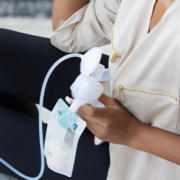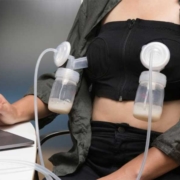Breastfeeding Basics
By Jacque Ordner BSN, RN, IBCLC
Breastfeeding is natural and the biological norm for feeding babies, but that doesn’t mean it’s easy! We’ve got you covered with top tips for getting started and avoiding common pitfalls.
The human breast continues to develop milk-making glands, ducts, and other structures involved with lactation throughout pregnancy. For this reason, it is normal to experience breast changes including an increase in size, increased sensitivity, darkening of the areola and nipple, and even leaking of colostrum in late pregnancy. These are all great signs that your body is getting ready to feed your baby!
After baby is born (more specifically, after the placenta is delivered) mom’s body experiences a hormone shift that triggers the production of breast milk. For the first few days, women’s bodies make a thick, sticky liquid called colostrum. Colostrum is a POWERHOUSE of nutrients and bioactive immune factors the help seal up your baby’s gut and protect him or her from illnesses. Colostrum is small in volume but is just what baby needs in the early days. Due to its thick, sticky consistency, colostrum can be difficult to express with a breast pump. Many moms have more success using hand expression. Here’s a great video with more information on hand expression in the early days: https://med.stanford.edu/newborns/professional-education/breastfeeding/hand-expressing-milk.html Newborn tummies are tiny and are made to stretch as mom’s milk supply increases in the initial postpartum period.
Placing baby skin to skin with mom and offering unlimited access to the breasts can have a huge impact on later breastfeeding success. Latching baby within the first hour is ideal. However, not latching in the first hour doesn’t mean breastfeeding will be unsuccessful! Breastfeeding is a new sensation but shouldn’t be painful. If you’re experiencing pain with latching or pumping, reach out for help from an IBCLC. Frequent nursing helps mom’s milk supply increase faster. Mothers make transitional milk (often somewhat yellow, very nutritious breastmilk) until about 6 weeks postpartum when transitional milk becomes mature milk (often whiter and more abundant breastmilk). If baby is unable to latch or is not nursing effectively, it is imperative that mom begin pumping with a high quality, hospital grade breast pump. Studies show that 120 minutes/24 hours of good quality nipple/breast stimulation is needed to bring in and maintain a full milk supply. A full milk supply (after about 6 weeks postpartum) is between 750ml and 1035ml.
Newborns nurse often! We often hear that babies should nurse at least 8-12 times in 24 hours, but it is also normal for them to nurse even more. If your newborn is producing 6-8 wet diapers in 24 hours and 3-4 dirty diapers in 24 hours, along with maintaining appropriate growth, then breastfeeding is likely going well! Remember, painful latching is a sign that something isn’t quite right even if baby is gaining weight well.
If nursing is going well, there is no need to pump right away! Many moms stress over when to add in pumping once they bring baby home. In general, if nursing is going well, there is no need to add in pumping until around 4-6 weeks postpartum. Pumping and nursing can lead to an oversupply of milk, and in-turn, increased risk of clogged ducts and mastitis. However, many moms choose to introduce pumping as they anticipate returning to work soon after delivery. If your baby requires a supplement, or if you are pumping milk for bottle feeding, Paced Bottle Feeding is key! Check out this great demonstration for tips on avoiding overfeeding and helping baby transition from breast to bottle and back: https://www.youtube.com/watch?v=2K3O3grKusA
Confidence is key! Moms and babies are made to breastfeed! If you are struggling with breastfeeding (pumping is breastfeeding too) or just need reassurance that things are going well, don’t hesitate to reach to an IBCLC for help! Our IBCLCs are available to support you as well. Email us at ibclc@spectrababyusa.com or set up a virtual consultation at www.spectrababyusa.com/lactationservices .
Sources:
Lawrence, R. A., & Lawrence, R. M. (2016). Breastfeeding: A guide for the medical profession. Philadelphia, PA: Elsevier.
Mohrbacher, N. (2012, November 27). How Much Milk Should You Expect to Pump? Retrieved July 27, 2020, from http://www.nancymohrbacher.com/articles/2012/11/27/how-much-milk-should-you-expect-to-pump.html










Leave a Reply
Want to join the discussion?Feel free to contribute!